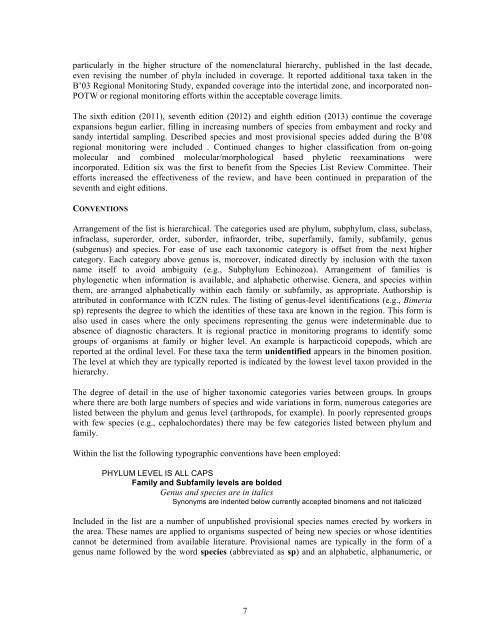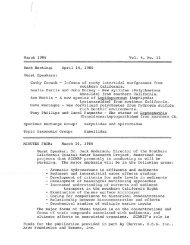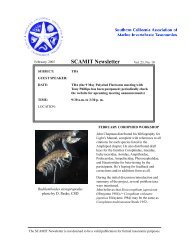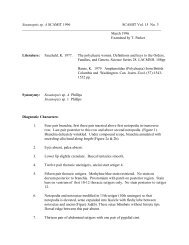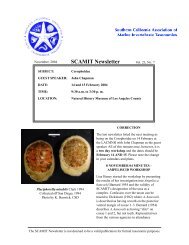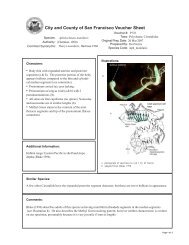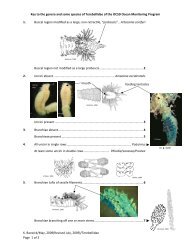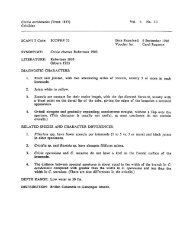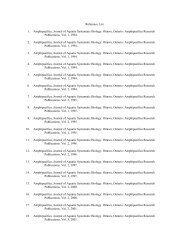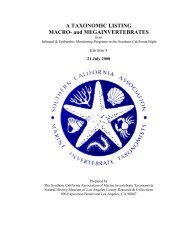A Taxonomic Listing of Benthic Macro- and Megainvertebrates - scamit
A Taxonomic Listing of Benthic Macro- and Megainvertebrates - scamit
A Taxonomic Listing of Benthic Macro- and Megainvertebrates - scamit
- No tags were found...
Create successful ePaper yourself
Turn your PDF publications into a flip-book with our unique Google optimized e-Paper software.
particularly in the higher structure <strong>of</strong> the nomenclatural hierarchy, published in the last decade,<br />
even revising the number <strong>of</strong> phyla included in coverage. It reported additional taxa taken in the<br />
B’03 Regional Monitoring Study, exp<strong>and</strong>ed coverage into the intertidal zone, <strong>and</strong> incorporated non-<br />
POTW or regional monitoring efforts within the acceptable coverage limits.<br />
The sixth edition (2011), seventh edition (2012) <strong>and</strong> eighth edition (2013) continue the coverage<br />
expansions begun earlier, filling in increasing numbers <strong>of</strong> species from embayment <strong>and</strong> rocky <strong>and</strong><br />
s<strong>and</strong>y intertidal sampling. Described species <strong>and</strong> most provisional species added during the B’08<br />
regional monitoring were included . Continued changes to higher classification from on-going<br />
molecular <strong>and</strong> combined molecular/morphological based phyletic reexaminations were<br />
incorporated. Edition six was the first to benefit from the Species List Review Committee. Their<br />
efforts increased the effectiveness <strong>of</strong> the review, <strong>and</strong> have been continued in preparation <strong>of</strong> the<br />
seventh <strong>and</strong> eight editions.<br />
CONVENTIONS<br />
Arrangement <strong>of</strong> the list is hierarchical. The categories used are phylum, subphylum, class, subclass,<br />
infraclass, superorder, order, suborder, infraorder, tribe, superfamily, family, subfamily, genus<br />
(subgenus) <strong>and</strong> species. For ease <strong>of</strong> use each taxonomic category is <strong>of</strong>fset from the next higher<br />
category. Each category above genus is, moreover, indicated directly by inclusion with the taxon<br />
name itself to avoid ambiguity (e.g., Subphylum Echinozoa). Arrangement <strong>of</strong> families is<br />
phylogenetic when information is available, <strong>and</strong> alphabetic otherwise. Genera, <strong>and</strong> species within<br />
them, are arranged alphabetically within each family or subfamily, as appropriate. Authorship is<br />
attributed in conformance with ICZN rules. The listing <strong>of</strong> genus-level identifications (e.g., Bimeria<br />
sp) represents the degree to which the identities <strong>of</strong> these taxa are known in the region. This form is<br />
also used in cases where the only specimens representing the genus were indeterminable due to<br />
absence <strong>of</strong> diagnostic characters. It is regional practice in monitoring programs to identify some<br />
groups <strong>of</strong> organisms at family or higher level. An example is harpacticoid copepods, which are<br />
reported at the ordinal level. For these taxa the term unidentified appears in the binomen position.<br />
The level at which they are typically reported is indicated by the lowest level taxon provided in the<br />
hierarchy.<br />
The degree <strong>of</strong> detail in the use <strong>of</strong> higher taxonomic categories varies between groups. In groups<br />
where there are both large numbers <strong>of</strong> species <strong>and</strong> wide variations in form, numerous categories are<br />
listed between the phylum <strong>and</strong> genus level (arthropods, for example). In poorly represented groups<br />
with few species (e.g., cephalochordates) there may be few categories listed between phylum <strong>and</strong><br />
family.<br />
Within the list the following typographic conventions have been employed:<br />
PHYLUM LEVEL IS ALL CAPS<br />
Family <strong>and</strong> Subfamily levels are bolded<br />
Genus <strong>and</strong> species are in italics<br />
Synonyms are indented below currently accepted binomens <strong>and</strong> not italicized<br />
Included in the list are a number <strong>of</strong> unpublished provisional species names erected by workers in<br />
the area. These names are applied to organisms suspected <strong>of</strong> being new species or whose identities<br />
cannot be determined from available literature. Provisional names are typically in the form <strong>of</strong> a<br />
genus name followed by the word species (abbreviated as sp) <strong>and</strong> an alphabetic, alphanumeric, or<br />
7


